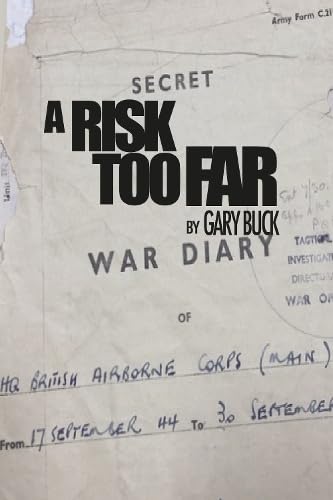You may have thought that another book on Arnhem was not necessary or that it could not possibly tell you anything you did not already know about this iconic battle from World War Two. However, Gary Buck’s new book, A Risk Too Far, takes a new and novel approach to the subject that has you reappraising the commonly held views and your own long-held conceptions. Whilst past commentators have been quick to apportion blame for the planning and execution of Operation Market Garden, Buck seeks to ask why and how errors might have been made.
A Risk Too Far blends historical research with psychological models and theories to examine the different cognitive influences and biases that individuals face when making decisions under stressful conditions. It focuses on three of the prominent commanders of Operation Market Garden: Field Marshall Bernard Montgomery, the commander of 21st Army Group who first conceived of the operation; Lieutenant-General ‘Boy’ Browning, the deputy commander of the First Allied Airborne Army and overall tactical commander for the operation; and Major-General Roy Urquhart, commander of the British 1st Airborne Division. It draws on both primary and secondary sources including memoirs, personal letters and reflections of both the subjects and their superiors and subordinates.
Whilst referencing important psychological theories and models, the book is structured around the OODA (Observe, Orientate, Decide, Act) loop which will be familiar to military readers. In so doing, Buck deftly brings out the human element of conflict, putting one in the shoes of those commanders, seeking to understand the decisions taken against the context and pressure they were under.
Studying Montgomery and the strategic level, Buck asks why he choose to embark on such a high-risk operation when he was usually so deliberate, meticulous, and careful? He examines the problems of supply and an acute manpower shortage faced by 21st Army Group that were becoming critical in the face of stiffening German resistance. Monty’s options are considered in light of the political impetus to prevent further V2 launches against London and his growing frustration with Eisenhower’s insistence on a broad front strategy. Analysing his character, Buck finds that Montgomery was facing acute pressures and had succumbed to what is known as a grip reaction in which he abandoned his normal analytical logical approach. Operation Market Garden was a gamble, but he had decided that it was worth it. For that to be true it needed some likelihood of success. For that, Buck turns to the operational level and Lieutenant General ‘Boy’ Browning.
Examining ‘Boy’ Browning we find that he was pushing for use of the First Allied Airborne Army, accepted risks in planning, and inexplicably opted to deploy his own Corps HQ in the first lift. A colourful character driven by pride and ambition, he was concerned with the diminishing possibilities for field command and to prove the continued utility of airborne forces. Faced with similar pressures to Montgomery, he was too optimistic and failed to raise concerns about a plan that could only really be successful under the best circumstances and with a significant amount of luck.
At the tactical level, Buck asks why Urquhart’s plan was so rigid and lacking in focus to the extent that only one battalion ever made it to the bridge in Arnhem? He examines how his lack of airborne experience led him to fall back on inadequate experience, to make illogical decisions under time pressure and to not question clear failings in the plan over a fear that his division might be broken up to solve Monty’s manpower shortage.
A Risk Too Far presents a thorough investigation of the span of strategic, operational and tactical aspects of the operation. It provides considerable food for thought with regards to how other fateful operations may have been planned and executed under similar circumstances. Usefully, Buck also articulates the ways in which commanders can guard against the effects of external factors on their own decision making. I found the approach taken in A Risk Too far to be highly compelling. The models and theories that Buck chooses to examine the psychology of the protagonists are explained in a way that held my attention and did not detract from the military history. The narrative is fast paced and easily digestible in well structured chapters.
A Risk Too Far is a book that should be read by all aficionados of Operation Market Garden – it will challenge their beliefs. Military leaders, both current and aspiring, should read it to understand their own fallibility. As his title suggests, when one examines the context and resulting psychology behind the decisions taken, Arnhem was never so much a Bridge Too Far, but a Risk Too Far.

